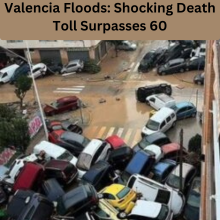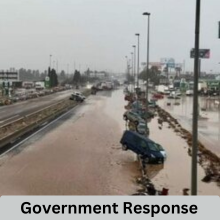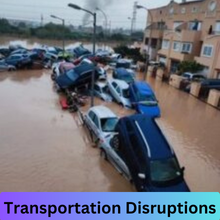
The flash floods in eastern Spain have turned towns into disaster zones, claiming at least 63 lives and disrupting the lives of countless others. This devastating event has left communities grappling with loss and destruction. As rainstorms unleashed chaos from Malaga to Valencia, the urgency of rescue efforts surged. Let’s delve into the details of this catastrophic event, exploring its impact, the government response, and the path to recovery.
The Scale of the Flooding
The flooding affected a broad area, with many towns submerged under rushing, mud-colored waters. Roads transformed into rivers, sweeping away cars and debris. The imagery of floodwaters engulfing streets illustrates the sheer force of nature that struck this region. In many places, the water surged to heights of three meters, leaving little behind but destruction.
Casualties and Rescue Efforts
The tragedy has left communities mourning the loss of loved ones. As of now, 62 fatalities have been confirmed, with rescue teams still searching for those unaccounted for. Emergency services deployed helicopters and boats, navigating treacherous waters to save stranded residents. Over 1,000 soldiers joined the rescue efforts, showcasing the government’s commitment to helping those in need.
Eyewitness Accounts
Survivors share harrowing stories. Ricardo Gabaldón, the mayor of Utiel, described a nightmare scenario: “We were trapped like rats.” The scenes he witnessed—a torrent of cars and debris rushing by—are etched in his memory. These personal accounts highlight the fear and chaos that reigned as communities faced unprecedented flooding.
Government Response
In the wake of this disaster, the Spanish government acted quickly. A crisis committee was established to coordinate rescue and recovery efforts. Prime Minister Pedro Sánchez visited affected areas, vowing to provide necessary resources to rebuild and support those impacted. This proactive approach aims to mitigate the fallout and reassure communities during this difficult time.
Weather Conditions Leading to the Disaster
The floods were triggered by intense rainstorms, a reminder of Spain’s increasingly volatile weather patterns. Scientists link these extreme weather events to climate change, suggesting that similar disasters may become more frequent. Understanding this connection is crucial for future preparedness.
Historical Context of Flooding in Spain
Spain has experienced its fair share of flooding, but nothing compares to the devastation seen recently. Previous incidents, like the 2021 floods in Germany and Belgium, claimed numerous lives. This latest disaster serves as a stark reminder of the risks associated with climate change and aging infrastructure.
Transportation Disruptions
Transportation has taken a significant hit during these floods. Rail services, including high-speed trains, faced interruptions, with one train derailing near Malaga. Fortunately, no injuries were reported, but the disruption highlights the vulnerabilities in transport networks during extreme weather events. Authorities have warned residents to stay off the roads due to fallen trees and wreckage.
Community Recovery Efforts
As waters recede, communities begin the daunting task of recovery. Cleanup initiatives are underway, with volunteers and local organizations stepping up to assist affected families. The spirit of solidarity shines through as neighbors come together to rebuild their lives and homes.
The Economic Impact
The economic consequences of these floods will likely be severe. Initial estimates suggest substantial damages that will take years to fully recover from. Businesses are left assessing losses, and families are grappling with the financial strain of rebuilding their lives. The long-term impact on the region’s economy remains to be seen, but it won’t be insignificant.
Looking Ahead
While the immediate danger has passed, authorities warn of more rain on the horizon. Residents have been urged to remain vigilant as rescue operations are ongoing.Preparing for potential future disasters is crucial, and lessons learned from this event must inform future planning.
Also read: Eli Lilly Stock Plummets: What Went Wrong This Quarter?
Importance of Infrastructure Improvement
One critical aspect of recovery will involve improving infrastructure. As climate change continues to pose challenges, enhancing resilience in communities is essential. Investing in better drainage systems and flood defenses can help mitigate damage in future storms, protecting both lives and livelihoods.
Community Solidarity and Support
The resilience of communities shines through in times of crisis. Local aid efforts are crucial in supporting recovery. Whether it’s food drives or financial contributions, community involvement plays a vital role in helping families get back on their feet. The strength shown during this disaster will be a cornerstone for rebuilding.
Also read: Apple’s Mighty Mac Mini: Performance You Won’t Believe
Conclusion
The flash floods in Spain have left a profound impact, showcasing the destructive power of nature. As communities mourn their losses, they also display incredible resilience. The government’s response and the solidarity of citizens highlight the importance of coming together during times of crisis. While recovery will take time, the strength and determination of these communities will pave the way forward.
FAQs
What caused the flash floods?
Intense rainstorms in eastern and southern Spain triggered the flash floods, overwhelming local drainage systems.
How are rescue efforts being coordinated?
Emergency services, military units, and local authorities are working together to conduct search and rescue operations in affected areas.
What measures are in place for future flood prevention?
Government officials are focusing on improving infrastructure, including drainage systems, to better handle extreme weather events.
How can the community support recovery efforts?
Community members can volunteer for cleanup initiatives, donate supplies, or provide financial support to affected families.
What lessons can be learned from this disaster?
This disaster highlights the need for better preparation for extreme weather events, emphasizing the importance of community resilience and infrastructure investment.

